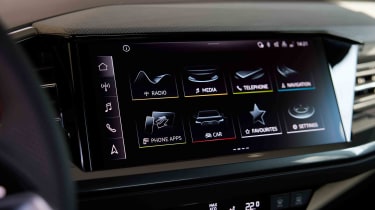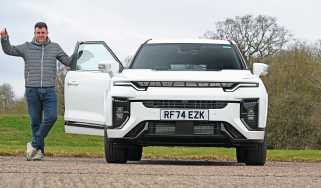Audi Q4 e-tron - Interior, design and technology
With typically impressive design inside and out, the Audi Q4 e-tron is most definitely a premium family SUV

Audi knows how to make a good-looking SUV, with the Q4 e-tron possessing a strong, muscular, but still subtle look that’s hard to disapprove of. Meanwhile, those who’d prefer not to shout about their decision to switch to electric should find that the Q4 e-tron hits the spot as the only obvious visual giveaway that this is an EV is the blanked-off grille panel, which is still Audi’s familiar hexagonal shape with the four rings sitting proudly below the nose, flanked by a slim, angular set of LED headlights.
Climb into the driver’s seat and you can tell Audi’s designers have worked hard to create a simple, uncluttered look to the cabin. The steering wheel is a little fancy with flat top and bottom edges and touch/swipe controls, but the drive selector switch is on a small panel that juts out from the lower dash, leaving lots of usable space below.
Material and build quality is excellent, with harder plastics used only for the lower parts of the doors. As is often the case though, the shiny piano black plastic on the centre pod looks great at first, but is soon covered in fingerprints and dust. At this point, we’re nitpicking because the cabin is generally top-notch.
Used - available now

2021 Honda
Civic
50,601 milesManualPetrol1.0L
Cash £11,610
2022 Vauxhall
Crossland
21,479 milesManualPetrol1.2L
Cash £12,214
2023 Honda
Jazz
5,401 milesAutomaticPetrol1.5L
Cash £21,722
2023 Honda
Jazz
3,816 milesAutomaticPetrol1.5L
Cash £20,605The central touchscreen is angled slightly towards you, which makes checking the maps easier while on the move. We also like that the Q4 e-tron features a set of physical climate controls with big chunky switches, rather than the touch-sensitive sliders you find in the VW ID.4 or ID.5 that use the same tech underneath.
There are three trim levels to choose from: Sport, S line and Black Edition. Equipment levels are generous, with all Q4 e-trons featuring Audi’s Virtual Cockpit instrument display, a 11.6-inch media touchscreen with built-in sat-nav, plus Apple CarPlay and Android Auto smartphone connectivity. Even entry-level Sport trim models come with 19-inch alloys, rear parking sensors, heated front seats, three-zone climate control and an automatic tailgate.
The ever-popular S line trim features 20-inch alloy wheels, an exterior styling pack, privacy glass, upgraded upholstery and sports suspension, while the range-topping Black Edition goes even further by adding 21-inch wheels, a gloss black exterior styling pack and a hexagonal twin-spoke leather sports steering wheel.
In terms of optional extras, the Technology Pack adds Matrix LED headlights, an upgraded SONOS sound system, a wireless charging pad and a couple of USB-C charging ports for rear passengers. The Technology Pack Pro builds on that by adding an augmented reality head-up display, a panoramic sunroof, a gesture-controlled powered bootlid and a 360-degree camera system. These add roughly £1,500 and £4,300 to the Q4 e-tron’s price tag, respectively.
If you're not fussed by the bundle of extra kit in the Technology Pack Pro, you can add the 360-degree camera is available as a separate option for just over £500, and comes bundled with a hands-free parking system. A folding towbar is another individual extra, priced at around £900, while a heat pump – which helps warm the cabin in winter and preserve the car’s range – cost an even £950.
Sat-nav, stereo and infotainment
The Q4 e-tron launched with the same 10.1-inch touchscreen as many other models in the firm’s range, although this has been upgraded to a bigger 11.6-inch display that’s still as slick as ever. The home page displays eight main menus presented in large tiles, which can be customised to suit the driver’s preferences. One swipe to the left – a motion that the system responds to quickly and smoothly – shows three larger widgets.
The built-in navigation uses Google satellite graphics which look fantastic, while loading times are fairly quick, too. The process from typing in a postcode via the on-screen keyboard to the system loading the route and giving the first instruction takes 25 seconds. If you prefer, there’s a full-screen map view option for the Virtual Cockpit display, so you don’t have to keep looking at the central screen for directions. Wireless Apple CarPlay is standard-fit, but you’ll need to use a cable if you want to hook up to Android Auto.












